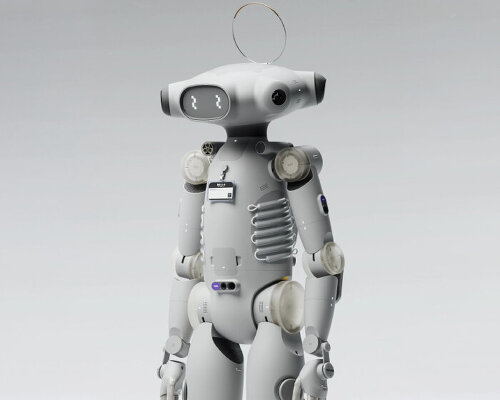Humanoid kriket 3000 revives look of robots in the past
Shaun Wellens conceives Kriket 3000, a concept humanoid that portrays how people in the 1950s and 1960s used to imagine futuristic robots. In a way, the project brings back the way people imagined the future. In the designer and artist’s work, the retro-futuristic reimagination comes through, from the smooth, rounded shapes of its body and its blinking lights to its chrome and pastel finishes and a face with multiple large ‘eyes’ and screens.
Looking at Kriket 300, the humanoid robot, seemingly AI-equipped, has a small form, and its body uses soft curves and clean lines that feel like classic product design from the 60s. It is much friendlier-looking compared to the modern machines, and its colors use soft tones, similar to white plastic, which can be a common shade in home appliances and some toys. With this, there’s a familiar domestic feeling to the concept humanoid robot, which makes Kriket 3000 more human-feeling rather than a machine.
all images courtesy of Shaun Wellens
Human-like machine equipped with cameras and sensors
There are evidently upgrades in Kriket 3000 which many of the robots back then lacked. The small digital displays around its head flash battery percentage and animations that seem to evoke moving eyes. Cameras surround the concept humanoid robot for detection, and within the body and head, installed sensors can allow it to detect movement and touch. Given the modern technologies, it’s likely that the designer and artist Shaun Wellens imagines Kriket 3000 to operate with AI capabilities, including learning habits from its owners and applying them to tasks.
In the 1960s and 70s, robots were mostly machines used in factories or even in science experiments. They were tasked to mainly build, especially automobiles, and they were mostly automated or arm-like. Take Unimate, dubbed the first industrial robot introduced in 1961. It worked on a General Motors car production line, moving hot metal parts that were too dangerous for people working there. These early robots didn’t have a face or look human-like; they were made of metal and followed uniform instructions. Since the advent of AI and many other new technologies, the faces and features of a humanoid robot seem to fall in line with how Kriket 3000 appears: equipped with sensors and cameras and able to talk to people and complete tasks on its own, to name a few.
project info:
name: Kriket 3000
design: Shaun Wellens | @shaunwellens
The post concept humanoid kriket 3000 draws design from portrayal of robots in 1950s and 1960s appeared first on designboom | architecture & design magazine.

